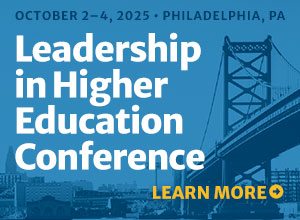This article first appeared in Academic Leader on January 1, 2018 © Magna Publications. All rights reserved.
A recent article, “Higher Education’s Data Experts Face a Crossroads,” in the Chronicle of Higher Education examines the changing profile of institutional researchers. Akin to the characters in the movie Ghostbusters, historically, they were the people you called for help when making decisions that required data.
One could argue that in this era of self-serve business intelligence, there is an expectation that all academic leaders and their staff will be data experts, finding the answers they seek with just a click of the mouse or a swipe of the finger. It is an admirable goal, and something that sellers of this type of software will tell you is achievable because you just “plug it in and it works.” In our reality of “more with less,” academic leaders struggle to manage the demands of their day-to-day operations; dedicating time in their busy days to the complexity of data analysis is just not an option. Turning to their support staff for assistance yields mixed results because many in these data-related jobs have never been trained in the nuanced world of data analysis, assuming that these software solutions will magically provide the Holy Grail of answers to all their problems.
Adding the ingredients of increased accountability, accreditation demands, and competition among schools for a declining high school graduate population results in a perfect storm for analysis paralysis. Universities know they need good data to make good decisions, but they lack the internal resources to make those strategic and operating decisions. As resources become scarcer, one of the most important decisions a university makes is who to hire. Those hiring opportunities are few and far between, so it is important to identify the expertise desired in our prospective employees. In the Chronicle article, Randy L. Swing, former executive director of the Association for Institutional Research, speaks of institutional researchers, but he could be speaking about all future hires when he states, “It’s a new day, and people will need new kinds of skills.”
So when it comes to data and this new skill set, what are universities looking for? A data scientist. Harvard Business Review called it the “sexiest job of the 21st century” and Information Week defined it as the “unicorn” of skill sets. The job title was coined in 2008 by D. J. Patil and Jeff Hammerbacher, then the respective leaders of analytics efforts at LinkedIn and Facebook. Demand for data scientists in the United States is projected to be 50–60 percent greater than the supply by 2018, resulting in a shortage of around 150,000 people. With starting salaries projected to be close to the six-figure range, it is no wonder that this job is one of the hottest in all industries, making these individuals difficult to hire and retain.
They are a rare breed: a true blend of art and science. They can coax treasure out of messy data and communicate it effectively—a powerful combination. Many of the data scientists employed in business fields today were formally trained in mathematics, computer science, or economics, but they can materialize from any field that has a strong data and computational focus. But having just that foundation is not enough, because data scientists also need the social skills to analyze problems creatively, collaborate with their colleagues to understand the business strategy involved, and present the findings visually and even artistically. The key characteristics are summarized below:
- Technical expertise: The best data scientists typically have deep expertise in some scientific discipline.
- Curiosity: They have the desire to go beneath the surface and discover and distill a problem down to a very clear set of hypotheses that can be tested.
- Storytelling: They have the ability to use data to tell a story and communicate it effectively.
- Cleverness: They have the ability to look at a problem in different, creative ways.
With so many colleges and universities feeling the bitter cold of hiring freezes and frozen budgets, they must turn to their own internal resources. So the question is: Who are your unicorns on-campus? Where do they live? Every campus is different, but odds are you will find them in one of these areas: institutional research, institutional effectiveness, or information technology.
Historically, there has been overlap in these three areas, so one question to consider is do they play well in the sandbox together? At many institutions, they do. But when areas overlap, sometimes toes are stepped on, so you need to be conscious of the dynamic between these three groups when requesting assistance from one or all of them. You also may find unicorns outside of these traditional areas; maybe it’s someone in the registrar’s office . . . or financial aid . . . maybe it’s someone in student affairs or someone in your fund-raising division. They are truly diamonds in the rough and worth seeking out.
These unicorns will help you drive the much-needed change in a data-informed culture, a world that relies more on facts and less on intuition, experience, or anecdotes. They will help you establish one centralized source of truth, turning data into information and institutional knowledge through analysis and interpretation. They will help you build relationships across departments, educating colleagues about the value of data and the importance of reporting on outcomes that are life-changing to your students, faculty, and staff. They will help you find the difference that makes a difference.
Richard L. Riccardi is senior associate provost and dean of libraries at Rider University.
References
Davenport, T. H., & Patil, D. J. (2012, October). Data scientist: The sexiest job of the 21st century. Harvard Business Review.
June, A. W. (2017, August 31). Higher ed’s data experts face a crossroads. Chronicle of Higher Education.



